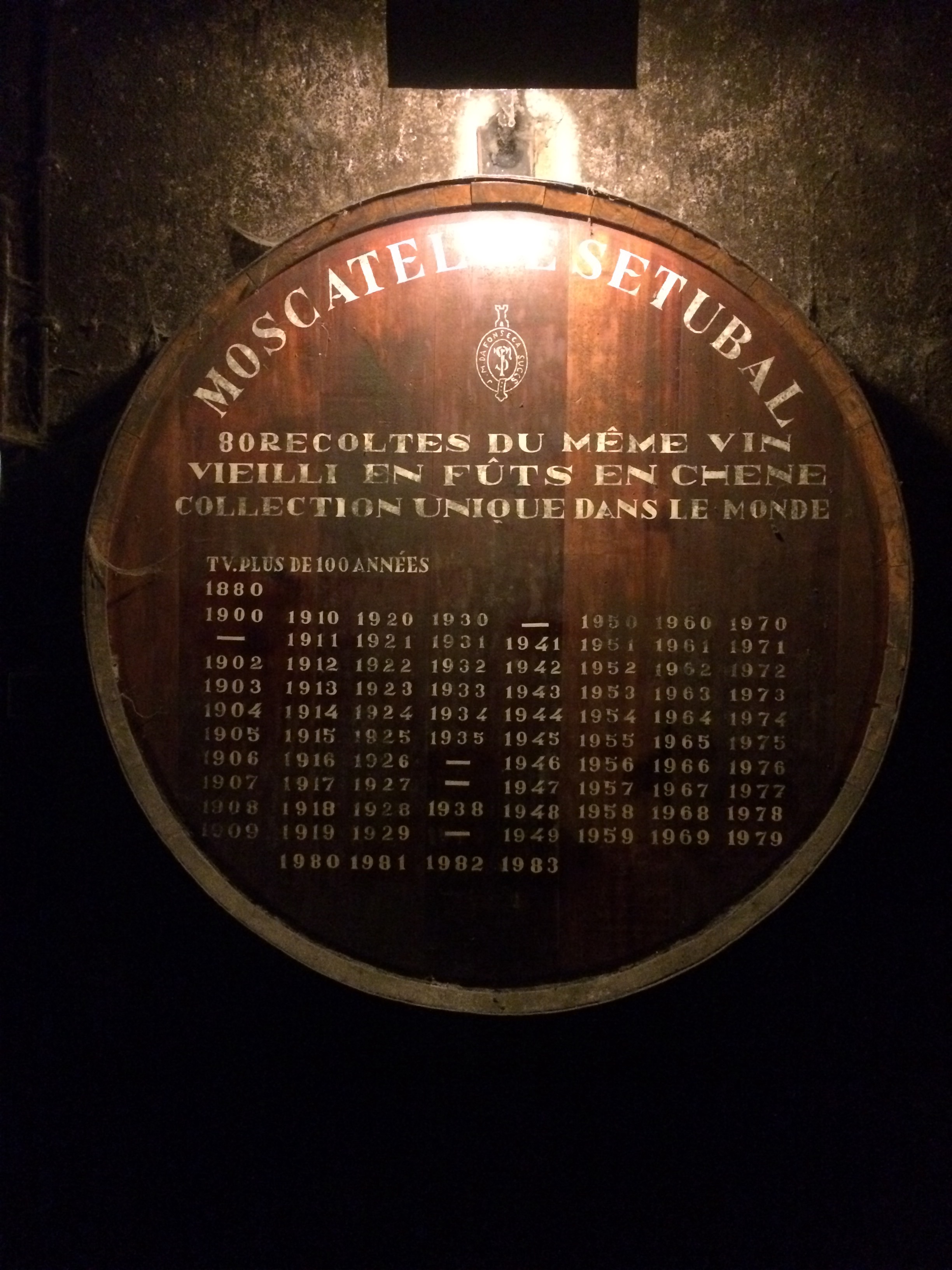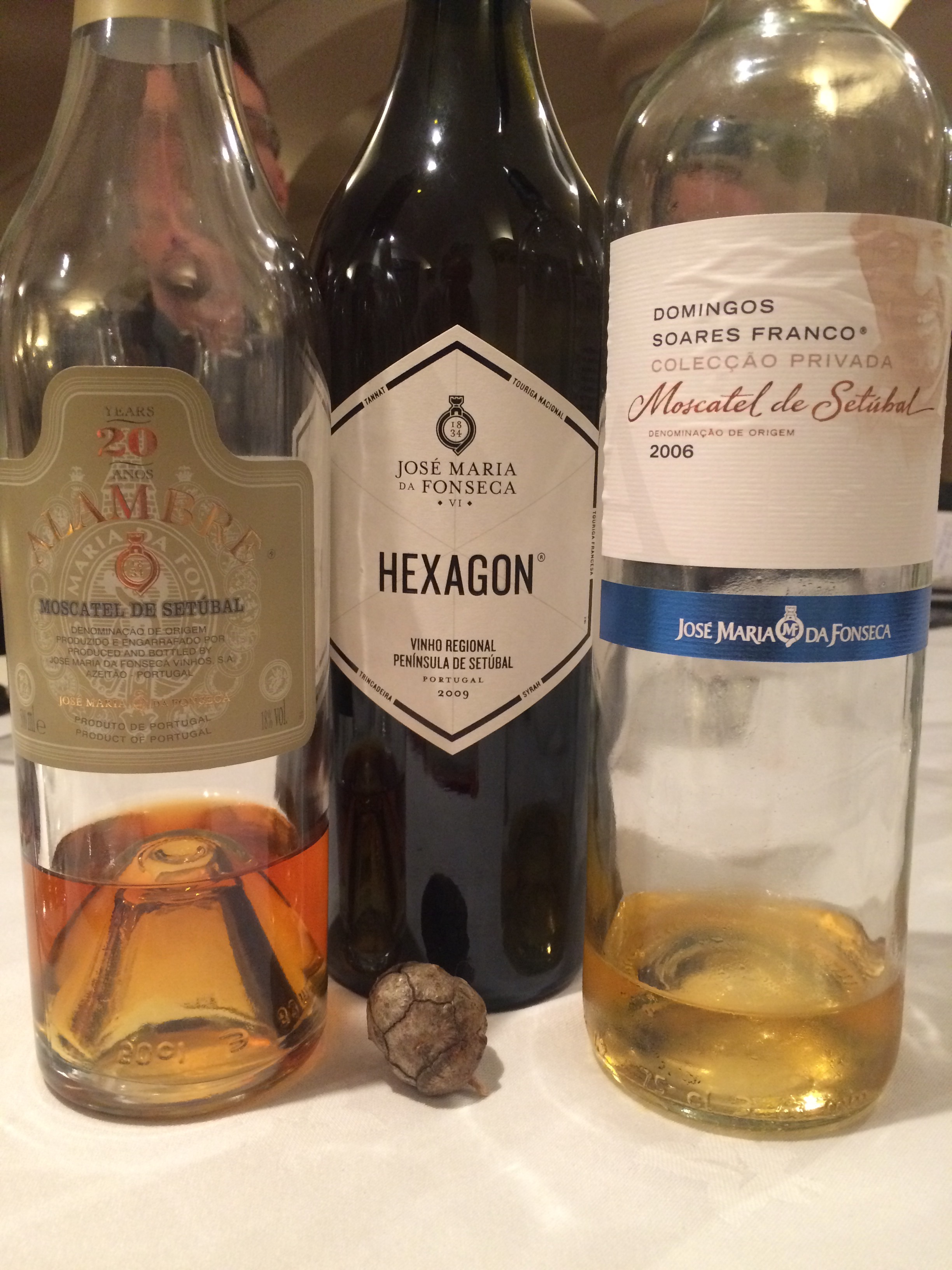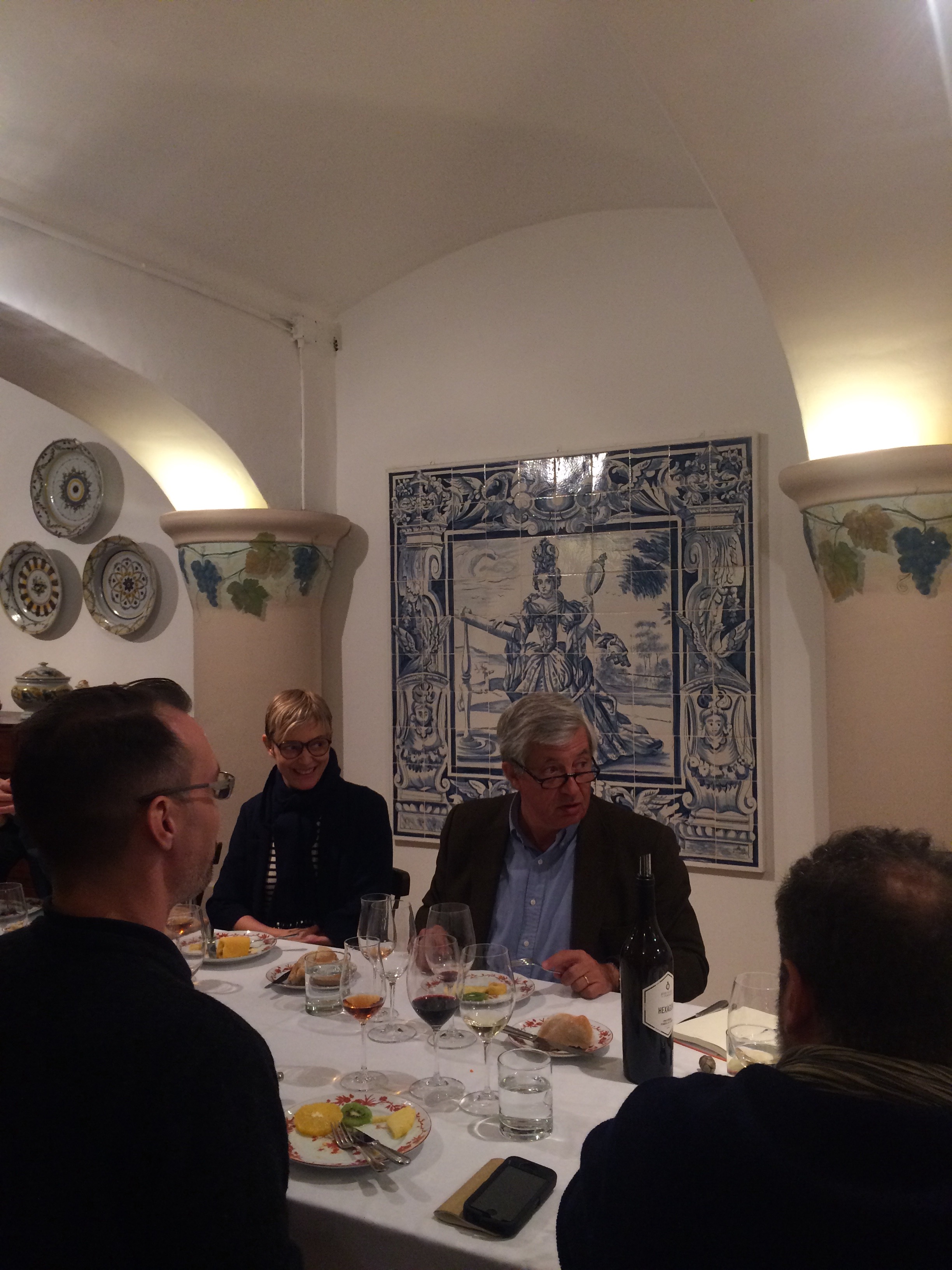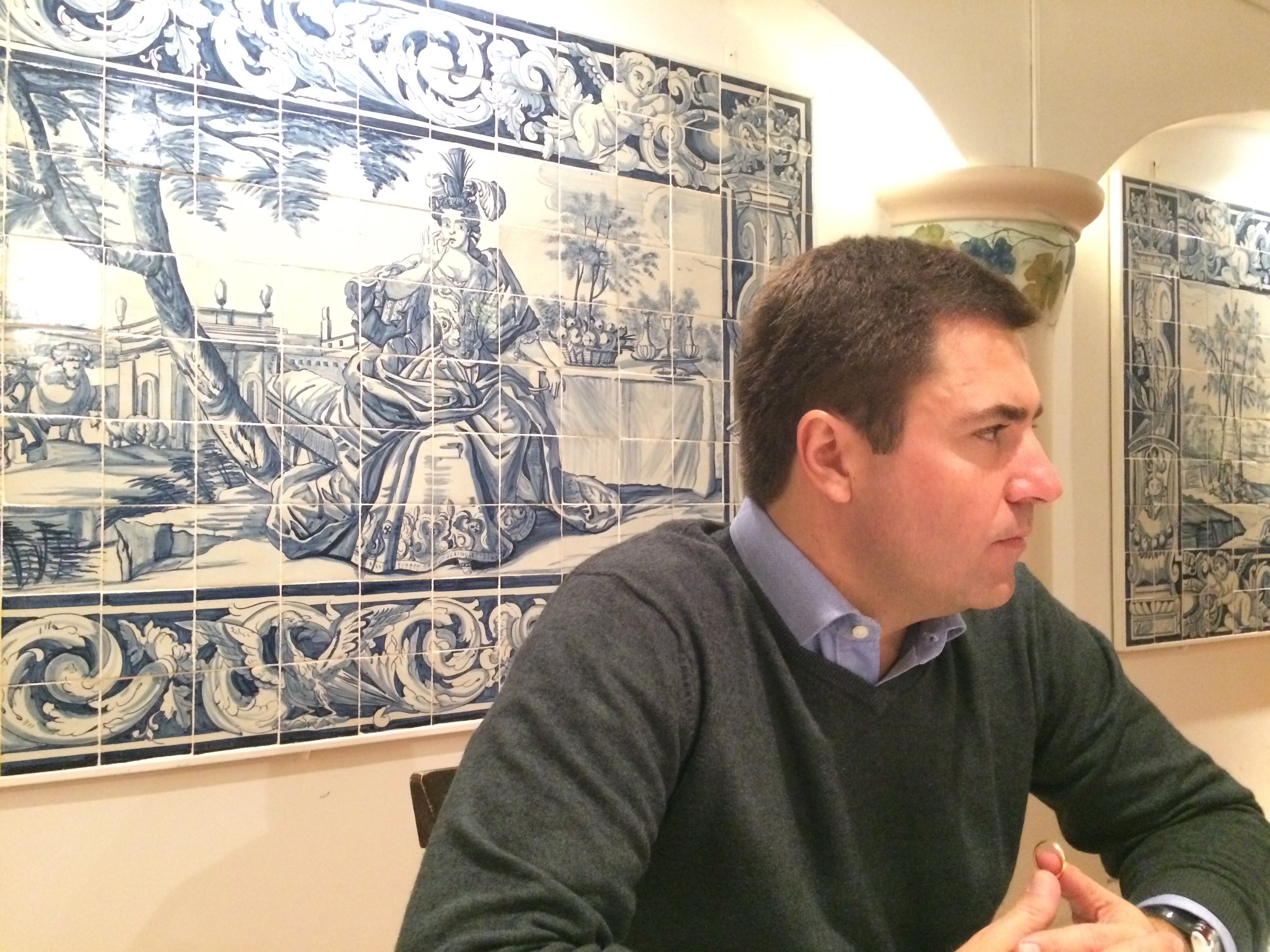A wine in a state of evolution. Great Langhe Nebbiolo is such a treasure when produced at this level of quality. That haunting aroma of Nebbiolo in its complex and mysterious form. A shape shifter in a glass. To taste it's fine grained and firm tannin with bright lashes of forest berry and strawberry compote, for me is pure delight.
SETÚBAL. / José Maria da Fonseca - A PORTUGUESE WINE DIARY
NOTES FROM A TRIP IN NOVEMBER 2016
It was soon time to leave the Alentejo and start the journey to the north of Portugal, though before going north there would be a visit to the house of José Maria da Fonseca. One of the longest standing wineries in all of Portugal and if it is not the first, it certainly is one of the very first wineries to export wines out of Portugal to International market.
Today the company has approximately 650 hectares under vine that can produce up to 6.9 million litres of wine. With 80% of their exports to Scandinavia, Canada, USA and Brazil and only 20% consumed domestically, da Fonseca is an example of a family run winery that has transformed itself into a well run company with deep roots in the Peninsula de Setúbal appellation. Under the wine guidance of Domingos Soares Franco, a graduate of the wine school at University of Davis in California, Domingos and da Fonseca are known as a leader in research, innovation and winery technology. On my first visit to Portugal in 2013 I had the opportunity to have lunch in the family garden with Domingos and his nephews. His nephews assist in the management of the company and it is their father António, whom I had lunch with on this recent visit, who is the CEO of the company.
Back in 2013 I had the opportunity to taste single bottling of over 15 different Portuguese grape varieties to better understand their character and what they each bring to the blending of wines. Yes the blending of wines is an art in which the best winemakers succeed at. A mastery in the Art of Blending is the key to consistent quality for the wines of Portugal, combined with innovation and improvements in the vineyard the potential is exciting. It is certainly the case for house of da Fonseca
2013 Tasting of Single Varietal Wines representing the Grapes of Portugal.
We engaged in a rather quick fire tasting before sitting to lunch. Below are my notes on the wines tasted.
2015 Perequita Branco. Sourced from the very first vineyard for the company, the Cova de Perequita. A blend of Verdelho, Viosinho, and Viognier. No oak, simply pure clean and fresh aroma of orchard fruit, pear with dried flowers. I would say that it was much less fruity and floral than I expected. This wine is direct, fresh and lean.
2015 Perequita Original. This wine is the original and first wine brand the first to be exported. Around 800,000 litres of this wine is made. Aged in 100 year old Mahogany barrels. Mahogany wood is preferred as it is neutral, and strong enough to be shaped into the barrel size the company prefers. The wine is a classic blend of Castelão, Trincadeira and Aragones blended producing an aroma of rather fresh ripe red berry, with gentle floral tones and on the palate moving to gentle tannin almost vegetal and earthy, leading into a soft mineral tone. The fruit on the palate is easy, fruit driven and tart. Good Value and Easy drinking.
2014 Perequita Reserva. The Reserve is a wine that was created roughly 10 years ago, the blue print is Castelão with Touriga Nacional and Touriga France. Vines are roughly 30-40 years old. This wine was made with sheer drinking pleasure in mind, it shares the same structure profile as the 'Original' Perequita, though we go deeper and richer with black berry fruit, seemingly sweeter fruit over layers of vanilla from French oak, and certainly a fuller bodied wine.
2014 'Domini', Tinto Douro. It was only in 1990 that da Fonseca purchased vineyards in the Douro and started making the 'Domini'. A blend of Touriga Nacional, Tinto Barroca, Touriga Frances and Tinto Roriz. I found this wine as I have with the other Douro I would taste on this trip, to be quite subtle in aroma and persistence. I feel that the wines need a lot of time, like the wines of Bordeaux. The palate seemed to reveal the future of this wine in aroma and palate evolution with dry dark berry fruit, some spice, and earthy tannin and texture. Almost like waiting outside of the club in the line that stretches around the corner, you can feel the bass and sound emanating through the walls, you know what to expect once you get inside the doors, but you still have to wait and be patient.
2014 José de Sousa Tinto Alentejano. The vineyards for this wine are in the heart of the Alentejo at a region called Requengos. The vineyards are cherished for their granitic soils, giving way to mineral and fresh wines despite the ripeness that vines can achieve in the heat of the growing season. So details on this wine, we stretch back to traditional methods with 10% of the wine raised in clay amphora with a grape blend of Grand Noir, Trincadeira and Aragonez. In the glass the wine displays ripe plum and berry aroma with violet floral perfume. Palate is rich and full ripe and baked dark fruit backed by firm tannin and crisp acidity. Despite all this the wine remains fresh and cool to the touch.
2010 'Alambre' Moscatel de Setúbal. Moscatel for me is by far the best value and one of the highest quality dessert wines out there. From a producer focused on quality and precision these wines never cease to please, even the most avid Sauterne or Tokaji connoisseur. Mind you that Moscatel is still very different. José Maria da Fonseca are specialist with Moscatel, the original Muscat of Alexandria. The Setubal displays an intense aroma of bergamot and orange, to rose petal and other floral tones, the palate remains light and elegant in its sweetness with balance. The wine is made from the free run juice from a first press and rests 5 yeas in very old oak barrel. Gentle yet sweet and one of the most balanced dessert wines I have come across.
We then sat down to lunch with António Sr. and we had a very lively conversation that ranged from politics, to world travel and to the history and future José Maria da Fonseca as a family run company.




ALENTEJO Part 2. / João Portugal Ramos - MY PORTUGUESE WINE DIARY.
EVORA CITY AND AN EVENING WITH JOÃO PORTUGAL RAMOS - November 2016
We, I arrived in Évora City (a Unesco World Heritage City), late in the afternoon, there would be only a few hours left of sunshine before the chill of the night would begin it's slow creep. I took a walk through the quiet yet busy city. Then suddenly realizing in my instant transformation into a tourist, that this historical city was alive with its inhabitants going about their lives. Children and Teenagers coming home from school, the elders sitting and sipping coffee in the town square, and offices closing up as the restaurants and taverns prepared for evening service. Dinner was to be at 8 at the charming Luar de Janeiro Restaurant with the wines of João Portugal Ramos. It would be a very comfortable dinner and a casual tasting with the wines and the son of João Portugal Ramos, João Maria Portugal Ramos. (pictured below)
João Maria Portugal Ramos, son of João Portugal Ramos. photo by Christopher Sealy iPhone using VSCO.
THE WINES OF JOAO PORTUGAL RAMOS OF ESTREMOZ, ALENTEJO
2015 Alvarinho Vinho Verde : a very fresh and clean wine with classic characteristics of apple and pear with bright fruit and mineral elements on the palate. 20% of the wine is raised in barrel, giving a soft and pleasing dimension to the wine and not overpowering the lovely fruit makes Alvarinho so pleasant as an aperitif wine.
2015 Marquês de Borba White: this wine is composed of Arinto, Antâo Vaz and a touch of Viognier. What I can say about this wine is that aromatically the wine is quite direct in character, with lovely lemon, citrus and orchard fruit tone with a touch of sweet peach and pear due to the Viognier, only to be balanced by a very pleasing palate with nice acidity and a lemon and mineral sandwich of flavour. Well made.
2015 Marquês de Borba Red : this wine is lead by Alicante Bouchet, Aragonez with support from Trincadeira and Touriga Nacional. As an easy drinking red, with lovely dark berry, currant and a touch of cooked fruit on the nose, which then moves direclty to the palate with like and similar elements framed by freshness and gentle tannin. Freshness and pleasing fruit is the vital and necessary key to good Alentejo wines. A great everyday drinking wine.
2013 Vila Santa Reserva Red : Grape Varieties in this gem are Aragonez, Touriga Nacional, Syrah, Cabernet Sauvignon and Alicante Bouschet. Now a 1/3 component of this wine will be foot trodden in classic marble lagares with the remainder fermented in large wooden vats with ageing in American and French oak. The result is rich and ripe fruit aroma of dark berry, cassis and a perfume that is floral and fruity with a hint of sweet vanilla. On the palate there is the same velvety richness with a touch of rock rose, spice and vanilla from the elevage in barrel. By no way is this an obtuse 'big' wine. It balanced and elegant showing the skill and hand of the maker.
2014 Dourum Colheita Douro Red : here Touriga Franca leads the show with Touriga Nacional and Tinta Roriz. We dig deep into the richness that only the Douro can provide with ripe and sweet berry over toasted vanilla and a touch of grains de café torréfié - roasted coffee. I would say and conclude later in my trip that the wine, and others wines of the Douro, had a Bordeaux like elegance and density, but with lift and clarity of pleasing fruit that allowed the wine to be enjoyed in youth.
FACT FILE ON JOÃO PORTUGAL RAMOS
“The new generation (of young winemakers) can profit from the work of their parents. The big producers will maintain a consistency in quality and the small producers will add the diversity to an already growing market. ”
- João is known as one of, if not the most famous oenologist/ wine consultants in Portugal and is constantly engaged in projects throughout the country. The Dourum label of wines in particular is a partnership with João Maria Soares Franco the famous and important past winemaker of Barca Velha. Barca Velha is the Portuguese equivalent to Vega Sicilia in Spain or Stag's Leap in Napa.
- In the 1990's João himself, after an illustrious career of making wines for others, purchased a property in Estremoz, Alentejo to make his own wines and then soon become one of the largest privately owned family wineries in the south.
- Currently they have a team of 6 wine makers in the group overseeing projects in other regions of Portugal.
- João's son, João Maria has recently finished his Masters in Wine at the wine school of Montpellier and has studied at Bordeaux. He has been working with his father since 2014 and is part of the new vanguard of young wine makers in training.
A morning walk in the public gardens at the city of Évora.
The outer wall of the city of Évora










